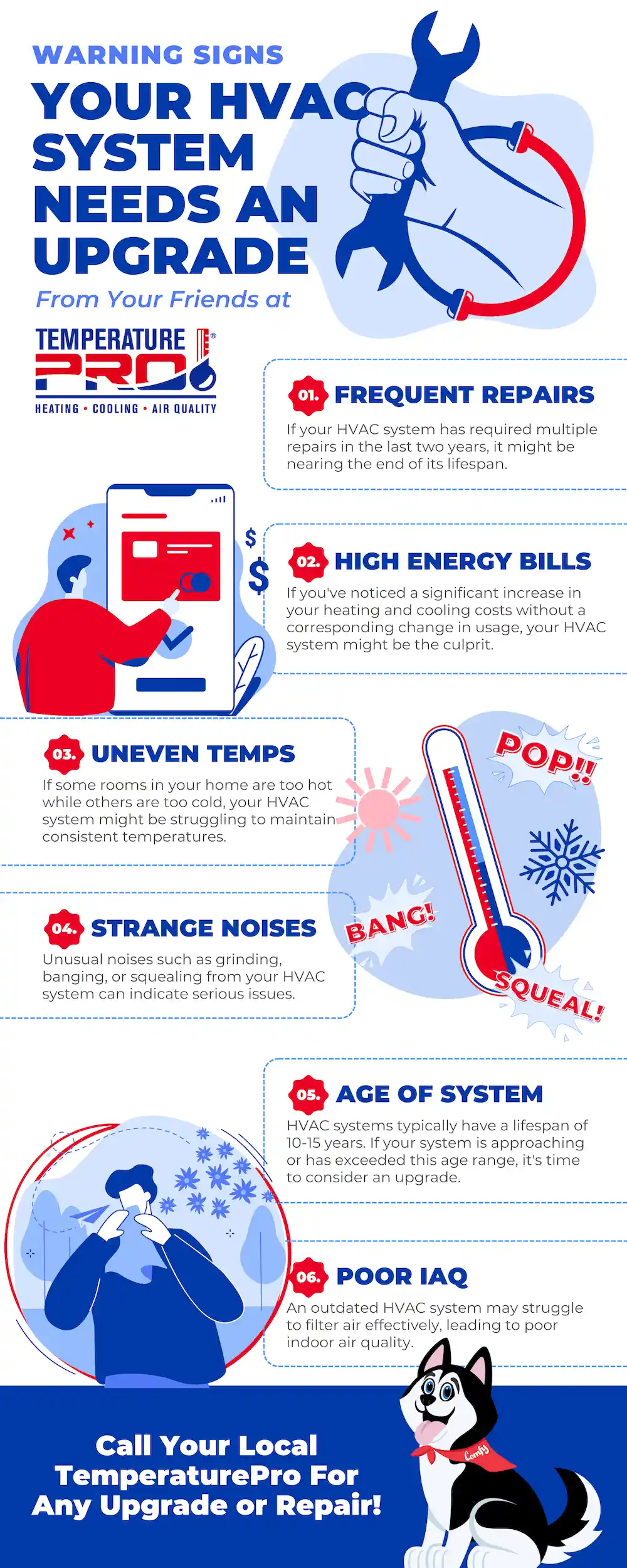The cooler weather of fall, offering a welcome break from the summer heat, signals that it’s the perfect time to assess your HVAC system and ensure it’s ready for the colder months ahead. Upgrading your HVAC system this fall can save you from unexpected breakdowns, reduce energy bills, and improve your home’s comfort. In this blog, we’ll explore the top signs that indicate your HVAC system needs an upgrade, provide a cost analysis of repairs versus replacement, and highlight the benefits of upgrading. Plus, take our interactive quiz to see if it’s time for a new HVAC system.
Warning Signs Your HVAC System Needs an Upgrade

- Frequent Repairs If you find yourself frequently calling for HVAC repairs, it may be more cost-effective to upgrade your system. Frequent breakdowns not only cause inconvenience but also add up in repair costs.
- Example: If your HVAC system has required multiple repairs in the last two years, it might be nearing the end of its lifespan.
- Cost Impact: Continuous repairs can cost hundreds to thousands of dollars, depending on the severity of the issues. When you schedule with a TemperaturePro HVAC Tech, we will always give you what you want, and never something you do not need. However, if in our inspection we discover that it might be worth it to replace the entire system, we can go over it with you step by step to ensure you’re making the best financial decision for your home.
- High Energy Bills An aging HVAC system often loses efficiency, leading to higher energy bills. If you’ve noticed a significant increase in your heating and cooling costs without a corresponding change in usage, your HVAC system might be the culprit.
- Energy Efficiency: Older systems typically have lower SEER (Seasonal Energy Efficiency Ratio) ratings compared to modern units.
- Example: A system with a SEER rating of 10 can be significantly more expensive to run than one with a SEER rating of 16 or higher.
- Uneven Temperatures If some rooms in your home are too hot while others are too cold, your HVAC system might be struggling to maintain consistent temperatures. This can be due to outdated technology or an improperly sized system.
- Comfort Level: Consistent temperatures throughout your home enhance comfort and reduce energy waste.
- Strange Noises Unusual noises such as grinding, banging, or squealing from your HVAC system can indicate serious issues. These sounds often signal that components are wearing out and the system is nearing failure.
- Maintenance: Regular maintenance can help identify and address these issues early, but persistent noises may mean it’s time for an upgrade. Be sure to let your TemperaturePro Technician know what kind of sound it is making when you schedule. Try your best to impersonate the sound – it may sound silly (and feel silly), but it truly helps your technician get a better idea of what they are looking for.
- Age of the System HVAC systems typically have a lifespan of 10-15 years. If your system is approaching or has exceeded this age range, it’s time to consider an upgrade.
- Technological Advancements: Newer systems offer improved energy efficiency, better performance, and advanced features like programmable thermostats.
- Poor Indoor Air Quality An outdated HVAC system may struggle to filter air effectively, leading to poor indoor air quality. This can exacerbate allergies and respiratory issues.
- Air Quality Improvement: Upgrading to a system with advanced filtration and air purification options can significantly improve indoor air quality.
Cost Analysis: HVAC Repairs vs. Replacement
When faced with frequent heating or cooling repairs, it’s essential to compare the costs of ongoing maintenance with the investment in a new HVAC system.
-
- Frequent Repairs
- Average Repair Costs: HVAC repairs can range from $150 for minor fixes to over $1,000 for major components.
- Cumulative Costs: If you’re spending $500 or more annually on repairs, it might be more economical to replace the system.
- New System Installation
- Cost of a New System: The average cost of a new HVAC system, including installation, ranges from $10,000-$5,000 (but bigger systems and more bells and whistles can cost significantly more) depending on the size and complexity of the system.
- Energy Savings: Newer systems are more energy-efficient, leading to lower monthly utility bills and potential savings of up to 20% on energy costs.
- Inflation Reduction Act: The Act can provide tax credits and point-of-sale rebates equaling thousands of dollars towards the replacement of aging equipment with the installation of high-efficiency HVAC equipment. We took a deep dive into the benefits and how to apply for this tax credit, which you can check out in our inflation reduction act post.
- Return on Investment (ROI)
- Frequent Repairs
-
-
- Increased Home Value: Upgrading your HVAC system can increase your home’s value, making it a worthwhile investment if you plan to sell in the future.
- Long-term Savings: With reduced repair costs and lower energy bills, the new system can pay for itself over time.
-
Benefits of Upgrading Your HVAC System
- Enhanced Energy Efficiency Modern HVAC systems are designed to be more energy-efficient, reducing your carbon footprint and saving you money on energy bills. Look for systems with high SEER ratings and Energy Star certifications.
- Improved Comfort Upgrading your HVAC system ensures consistent temperatures throughout your home, enhancing overall comfort. Advanced features like variable speed motors and zoning capabilities allow for precise temperature control.
- Better Indoor Air Quality New HVAC systems come with advanced filtration options that can significantly improve indoor air quality. Features like HEPA filters, UV lights, and air purifiers help remove allergens, dust, and pollutants.
- Smart Technology Integration Modern HVAC systems can be integrated with smart home technology, allowing you to control your system remotely via smartphone apps. Programmable thermostats and smart sensors optimize energy usage based on your preferences and schedule.
- Reduced Environmental Impact Newer systems are designed to be more environmentally friendly, using refrigerants that have a lower impact on the ozone layer and reducing greenhouse gas emissions.
- Quiet Operation Advanced HVAC systems operate more quietly than older models, creating a more peaceful home environment.
- Warranty and Support Upgrading to a new HVAC system typically comes with a manufacturer’s warranty, providing peace of mind and protection against unexpected repairs.
Is it time to upgrade your heating system? We explain the differences between common heating systems like furnaces, boilers, heat pumps, ductless mini splits and more. Compare the pros and cons of each on our heating replacement page.
Interactive Quiz: Do You Need an HVAC Upgrade?
Take our TemperaturePro quiz to determine if it’s time to upgrade your HVAC system. Answer the following questions:
- How old is your HVAC system?
-
-
- A) Less than 5 years
- B) 5-10 years
- C) 10-15 years
- D) Over 15 years
-
- How often do you need to repair your HVAC system?
-
-
- A) Rarely
- B) Once a year
- C) Multiple times a year
- D) Almost every month
-
- Have you noticed an increase in your energy bills without an increase in usage?
-
-
- A) No
- B) Slight increase
- C) Moderate increase
- D) Significant increase
-
- Do you experience uneven temperatures in different rooms?
-
-
- A) No
- B) Occasionally
- C) Frequently
- D) Always
-
- Are there unusual noises coming from your HVAC system?
-
-
- A) Never
- B) Rarely
- C) Often
- D) Always
-
- How would you rate the air quality in your home?
-
-
- A) Excellent
- B) Good
- C) Fair
- D) Poor
-
- Do you have a programmable thermostat or smart home integration?
-
-
- A) Yes
- B) No
-
Quiz Results:
- Mostly A’s: Your HVAC system seems to be in good condition. Regular maintenance should keep it running efficiently.
- Mostly B’s: Your system is starting to show signs of aging. Consider a professional evaluation with TemperaturePro to determine if an upgrade is needed.
- Mostly C’s: Your HVAC system is likely nearing the end of its lifespan. Upgrading now can save you money and improve comfort.
- Mostly D’s: It’s time to upgrade your HVAC system. The benefits of a new system will far outweigh the costs and inconvenience of ongoing repairs.
Utilize These Signs To Make Informed Decisions About Heating Replacement
Upgrading your heating system this fall can provide numerous benefits, from improved energy efficiency and comfort to better indoor air quality and reduced repair costs. If you’ve noticed any of the warning signs mentioned above, it might be time to invest in a new system. Contact TemperaturePro for a professional evaluation and to explore your options for upgrading to a modern, efficient HVAC system.
For more information and expert advice, visit our blog on Energy-Saving Tips for Optimal HVAC Performance in the Fall, and check out our detailed articles on HVAC maintenance and upgrades.
Sources:
By staying proactive and upgrading your HVAC system when needed, you can enjoy a warm, comfortable home throughout the fall and winter seasons.






